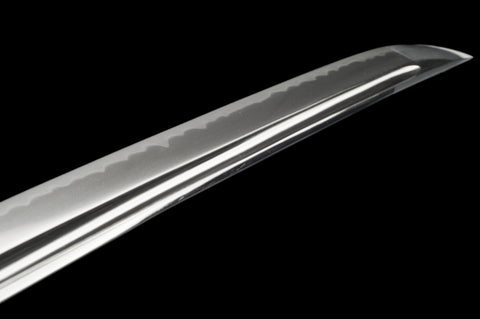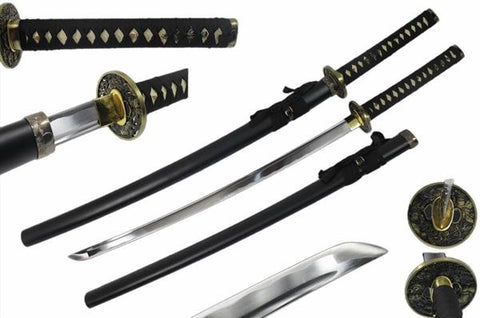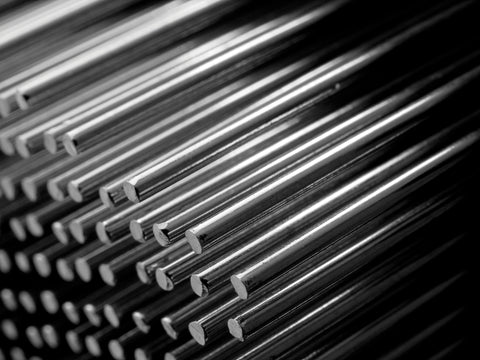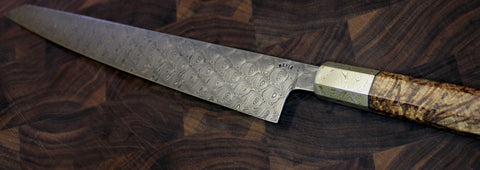Guide to Types of Sword Steel – Everything You Didn’t Know You Needed to Know
5 minute read
When doing research for your next sword purchase, invariably the question “which type of sword steel is best?” will arise. The answer will depend on the qualities desired of the sword and the uses to which the sword will be put. Thus, we have put together this guide in order to better help you answer that question. If you already know what you are looking for, use the links below to skip to the relevant section. Otherwise, continue reading for an explanation on why steel types matter and how they affect the blade.
Attributes of Steel

Swords start out as billets of steel that are heated and hammered repeatedly into the desired shape. Depending on the skill of the swordsmith and the quality desired, this can take anywhere from a few hours to a few months. There are three main factors that affect the properties of the sword produced
- Carbon Content and Purity
- Construction Method
- Tempering Method
Carbon Content and Purity
Steel is made from iron with a small amount of carbon (often 1% or less). This tiny addition has a dramatic impact on the attributes of the steel, with a change of even a tenth of a percent mattering. Blades with lower carbon contents (less than 0.5% carbon) are very tough and flexible, being able to withstand a ton of abuse without breaking. They are also more corrosion resistant, requiring less maintenance. Because of these qualities, blades made of lower-carbon steel make excellent swords for beginners. Higher-carbon swords (more than 0.5% carbon) are harder. They can take a sharper edge and keep it longer, but they are also more brittle and chip easier when used incorrectly. In addition, they rust faster if they are not properly maintained. For these reasons, higher-carbon steel swords are used more often by proficient and expert users, whose skill can mitigate the downsides and take advantage of the sharper edge.
As you can infer from the above, the purity of the steel and homogeneity (uniformity) of the carbon content is very important, as a heterogeneous blade made from variously imbued carbon would have random properties throughout the sword - an undesirable prospect in a weapon used to protect one’s life. In Japan, swordsmiths had access to only iron sands, which vary considerably in carbon content. Because of this and the inability of the forging methods of the time to produce temperatures high enough to completely melt and thus mix the steel, they were forced to develop an ingenious way of homogenizing the carbon content called folding. Folded steel was created by hammering the steel flat, folding it, and forge welding it to itself. This allowed impurities to be beaten out and the carbon content to be more evenly distributed throughout the blade. While not needed today because of the access to pure and homogeneous blocks of steel, the folding process had a unique by-product: the thousands of layers produced a mottled look that is still appreciated today for its aesthetic qualities.
Construction Method
A sword has to meet two seemingly contradictory requirements. The edge of the sword needs to be hard, so it can take a sharper edge to cut more effectively. The spine of the sword needs to be thick enough that it doesn’t bend excessively, without being so stiff that it breaks on impact.
To meet these requirements, several sword lamination methods were developed in antiquity. Maru construction is not laminated, as it is a whole sword being made from only one type of steel. Kabuse is laminated, using two types of steels, with a hard edge steel being fitted around a soft core steel. Honsanmai and Shihozume add a third type of steel, skin steel,
Today, because of the high purity of steel and the access swordsmiths have to the different types of carbon steel, most swords are made using Maru, with Kabuse less common (though sometimes available on request). The other lamination types (of which there are many more than the ones discussed here) are typically not used in modern times.

Tempering
A somewhat less effective way of creating a hard edge and a soft spine is through differential tempering. This method is highly preferred in modern times, as the quality and purity of modern steel is such that the above-mentioned lamination methods are not needed to produce similar results.
A sword is usually differentially tempered by applying clay to the blade (called clay tempering). The blade is heated, clay is applied to the spine, then the blade is cooled. The edge, with no clay covering, cools quickest, becoming very hard, while the spine cools slower, remaining relatively soft and flexible.
One side-effect of clay tempering is a Hamon line. This is a visible line produced by different colorations of the steel marking where the clay was applied. Only swords that are clay tempered have a natural Hamon. Swords that aren’t clay tempered may have a Hamon - but it is applied by a special liquid and is not part of the steel.
Types of Steel
Stainless Steel
This type of steel has chromium, which makes the blade tougher, softer, and more corrosion resistant than comparative carbon steels. Knives and swords made from stainless steel are usually not shaped by forging, but by stock removal (similar to sculpting rock). Because such swords are not made by traditional methods, they are not legal for import, thus none of our swords are stainless steel.
Carbon Steel
Each type of steel is represented by a unique 4-digit code. Because we are concerned with swords, we will mostly stick with steels denoted by 10XX. The “10” stands for plain carbon steel, and the XX for the amount of carbon in the steel, in hundredths of one percent.
1045
Composed of 0.45% carbon, this lower carbon steel is tough and able to take a beating. It is also relatively resistant to corrosion. In addition to being the cheapest type available in battle-ready swords, this type of steel is preferred by beginning practitioners as it is more forgiving to being wielded improperly and requires less maintenance. The main drawback of this type of steel is that it cannot take as sharp an edge as higher steel types and will lose it faster.

1060
Composed of 0.60% carbon, this type of steel is middle-of-the-road for swords. Less tough and resistant to corrosion than lower carbon steels, it is harder and able to take and keep a sharper edge. This steel type has enough carbon content to produce a noticeable Hamon when differentially tempered.
1095
Composed of 0.95% carbon, this type of sword is the least tough and resistant to corrosion, but also the hardest and able to take and keep the sharpest of edges. Unforgiving to being wielded improperly, this type of steel is preferred by proficient and expert users who can mitigate its drawbacks while making full use of its strengths.
Spring Steel
Spring Steel is a high-carbon steel alloy. It is so named because of its ability to return to its original shape even after experiencing significant stress or distortion. Spring steel is often used to make swords for theater and movie productions because of its resistance to bending, chipping, or shattering.
T-10 Steel
T-10 steel is a Chinese equivalent of 1095 steel, but with a crucial difference - Silicon is added to the alloy mix in order to improve the overall strength of the steel and additionally to increase its wear resistance. T-10 steel swords take to tempering very well, producing a sword which takes and retains an edge. In the same vein as 1095 steel, T-10 steel has low resistance to corrosion, therefore, it must be carefully looked after in order to avoid rust.

Forging Techniques
The below are not steel types in and of themselves, but are created using special forging techniques, thus they can be used on any of the steel types mentioned above.
Damascus
The method of making true Damascus steel was lost in the 1800s, but may have been recently rediscovered. However, modern swords carrying the name are made from several types of layers of steel that are forge-welded together, creating a similar mottled look.

Folded
Originally used to homogenize and purify the steel, folding is now practiced mainly for traditional reasons and for the aesthetic value of the thousands of layers they produce in the blades. As it takes longer to make such a sword, they are often more expensive than plain carbon steel blades.
Clay Tempered
Used to give the sword a flexible spine and a hard edge, clay tempering produces the highest quality blades, at a correspondingly higher cost. It can be combined with folding to produce a beautifully distinctive, high-quality blade.
